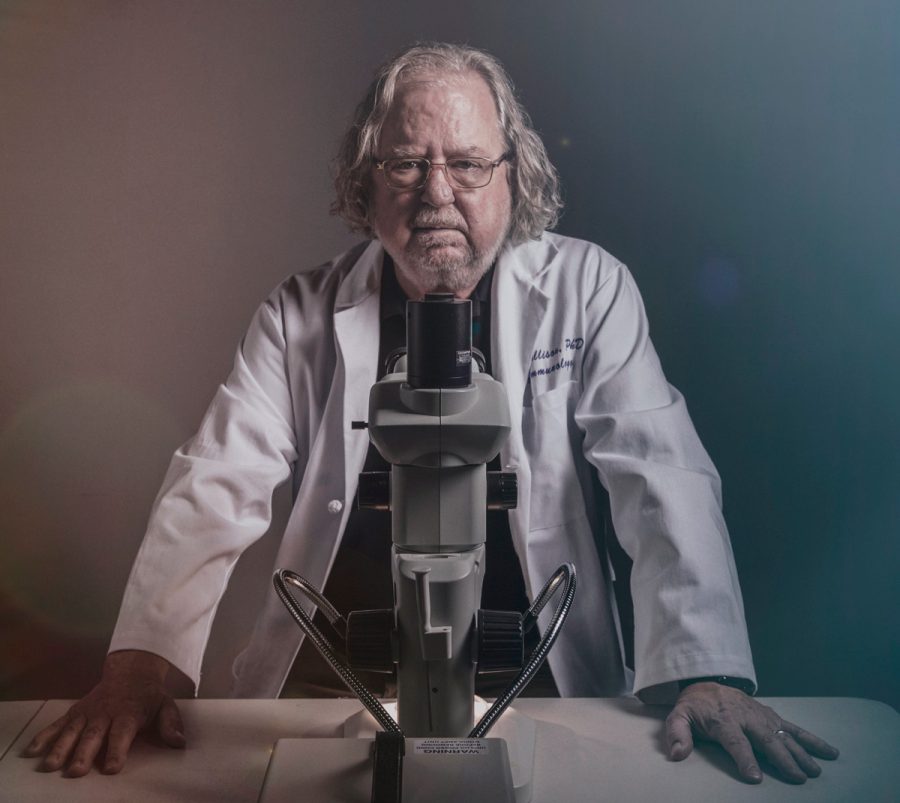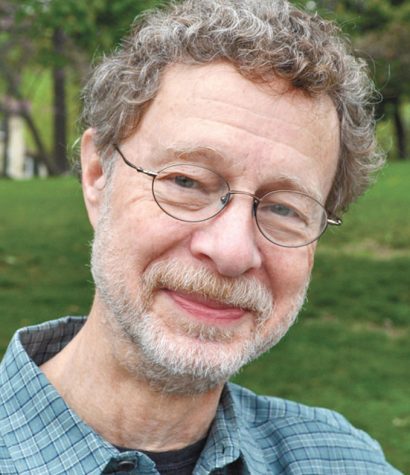Breaking through old thinking in medicine
Published October 3, 2019
Watching the new documentary “Jim Allison: Breakthrough,” which opens Friday, Oct. 4, at the Tivoli Theatre, I considered the possibility that if James Allison had been born 15 or 20 years sooner, my mom might be alive today.
Allison, 71, chairs the department of immunology at MD Anderson Cancer Center at the University of Texas in Houston. In 2018, Allison shared the Nobel Prize for Physiology or Medicine with Tasuku Honjo, a physician and professor of immunology and genomic medicine at Kyoto University in Japan.
Working separately over many years of their respective careers, the two men and their colleagues defied ingrained negative attitudes in the medical field about immunotherapy. They trusted their knowledge, instincts and data. They respected the principles of basic scientific research. And they persisted. Eventually, they discovered how to enlist the T cells of patients’ own immune systems in battles against certain kinds of cancers. It had never been done before.
ADVERTISEMENT
“By stimulating the ability of our immune system to attack tumor cells,” the Nobel citation read, “[Allison and Honjo] have established an entirely new principle for cancer therapy.” That new principle means that some patients may have immunotherapies available to help them fight some kinds of cancers in addition to the three treatment categories we’ve become accustomed to: surgery, radiation and chemotherapy.
In other words, the discoveries of Allison and Honjo, made despite great skepticism and even hostility in some medical circles, truly have changed the reality of cancer treatment. The U.S. Food and Drug Administration has since approved for use a half-dozen or so drugs and processes intended to unleash the power of the immune system against cancers. More are in the development/testing pipeline.
The documentary shows us how this came to be, at least with respect to Allison. (Honjo is ignored.)
In home movies of the Allisons, shown early in the film, we see shots of toddler Jim playing with his brothers and mother on a Gulf of Mexico beach an easy drive from their home in tiny Alice, Texas. Then we hear the off-screen voice of the adult Jim.
ADVERTISEMENT
“I was 11 years old when my mom died,” he says. “I sat on the bed with her and held her hand while she died.” The cause, he later learned, was lymphoma.
Allison says that losing her left a huge hole in the Allison family and that his father, a small-town family doctor, was undone by his grief. The period produced traumatic disruptions in Jim’s childhood. He spent a lot of time by himself.
The loss of his mother to cancer also was a factor in his later decisions about education. An especially bright and stubborn kid, he became focused on the sciences in his studies and grew determined to specialize in basic research into human biological systems.
I was 24 years old when my mom died at age 49. On Valentine’s Day, 1972, after several months of poor health with puzzling symptoms and no substantive answers for what was wrong, she was diagnosed with a particularly virulent strain of non-Hodgkin’s lymphoma. Nearly half a century ago, her doctors said they had no reasonable treatment options to offer, other than pain medication. She died 18 days later, the family at her bedside in the hospital.
My notion that an earlier birth date for Allison would have meant earlier discovery of his immunology advances is more wistful musing than rational speculation. I mean, even under perfect conditions, how likely is it that anyone lives to the age of 97, which my mom would be now? But might my sister and brothers and our dad have had more time with her if Allison’s and Honjo’s earlier discoveries already had led to new treatment possibilities for her lymphoma? I wondered about it throughout the 90-minute documentary.
“Breakthrough” tracks Allison’s early schooling, graduate studies and then his career emphasis on basic science in medical research, rather than pharmaceutical development. He moves from institution to institution: Scripps Research in Southern California; an MD Anderson research outpost in Smithville, Texas, near Austin; University of California at Berkeley; Memorial Sloan-Kettering in New York; and, finally, MD Anderson headquarters in Houston.
The documentary’s director-producer-writer, Bill Haney, uses cinematic techniques to magnify an aspect of Allison’s personality through which he becomes the star of his own story with a kind of heroic stature that we admire. Astutely edited sequences of still and moving images, interviews with Allison and other researchers and Allison’s interactions with his colleagues, friends and family all reinforce this persona.
Allison’s personality remains consistent and credible: professionally confident, personally modest, determined to not put on airs, comfortable in ragged-looking clothes and fly-away hair you’d be more likely to see on a rock musician than a Nobel-Prize-winning, senior research scientist at one of the most prestigious medical institutions in the world.
To make sure we don’t miss this seeming-contradiction, director Haney returns several times to footage of Allison playing blues harmonica on stage with Willie Nelson and his touring band and off stage with, well, himself. Allison’s been playing since he was a kid, we’re told, and he has serious blues chops. But Haney overdoes it.
And then he overdoes it more. Haney has his composer, the very fine musician Mark Orton, overload the musical score with even more harmonica sounds. Less would have been more.
The same can be said of some production touches that serve no cinematic or narrative purpose. These include a few slow-motion sequences that seem to exist only to make those scenes last a few seconds longer than they would at standard speed.
More problematic: The documentary is clearly and understandably enthusiastic about Allison’s groundbreaking scientific discoveries and the successes some patients have enjoyed with anti-cancer immunotherapies. But that only increases its obligation to emphasize the therapies’ documented success/failure rates, the limited kinds of cancers for which treatments have been approved so far and the widely varying experiences that individual patients have had, including side effects, with some drugs that free the immune system to fight. The film falls short on fulfilling that responsibility.
And I was troubled to learn that filmmaker Bill Haney also is the co-founder of two biotech companies, one of which is involved in developing drugs for immunotherapies against cancer. That gives him a different kind of financial interest in the way the content of the documentary is presented.
Additionally, both of Haney’s firms include financial partnerships with some of the major biotech companies, which means Haney is in business with some of the companies whose actions are described in his film about Allison.
Given those facts, it’s not unreasonable for viewers to wonder if this is a straightforward fact-driven documentary, a finance-driven element of a business plan or some of both.
These questions aside, let me be clear: In “Jim Allison: Breakthrough,” Allison comes across as a compelling figure, a ferociously dedicated scientist and a decent person. His story is touching, inspiring and fascinating. His discoveries (and Honjo’s) are genuinely groundbreaking and have enormous potential to cure deadly diseases and improve human life.
The film is worth seeing.
Eric Mink is a freelance writer and editor and teaches film studies at Webster University. He is a former columnist for the St. Louis Post-Dispatch and the Daily News in New York. Contact him at [email protected].

















